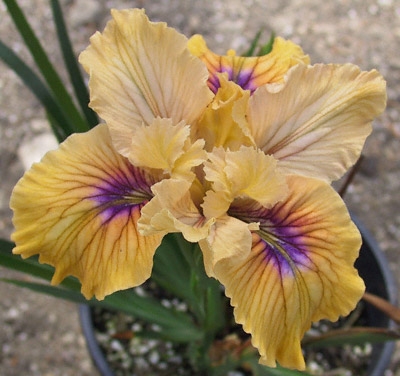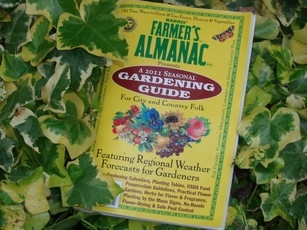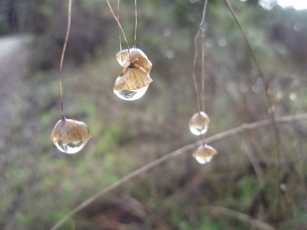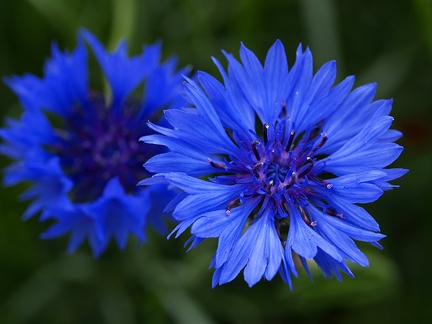I don’t know about your plans for the summer, but I’ll be sticking close to home. What with the price of gas and groceries, I’m planning a couple of camping trips in our great state. I guess you could say I’m going to be enjoying a "staycation".
With my attention directed more to the home front, I want to focus especially on making sure I have color in my garden every month of the year. I love my  so I want to fine tune my containers and plantings so they attract as many of these small wonders as I can.
so I want to fine tune my containers and plantings so they attract as many of these small wonders as I can.
While making an entry in my journal recently, noting the progress of my pet trees, shrubs and perennials, I was struck by the realization that I don’t have enough color in my garden in the month of May. You’d think "April showers bring May flowers" would have done the trick but our cool weather has slowed things down a bit. I love my white calla lilies, Doublefile viburnum and bleeding hearts but all that white is a little too quiet for my tastes. I was sorry to see my vivid late red tulips finally drop their petals in the rain. Their absence leaves a void I plan to fill right away. I want a few hot samba colors to punch up my landscape.
I like many color combinations. I could go with pale orange with white. They look great together. If I choose a variegated salmon Abutilon ( Flowering maple ) as a focal pint, I might pair it with orange calibrachoa, a rust colored coleus, bonfire begonia, Gartenmeister fuchsia and a Catlin’s Giant ajuga to tie it together. They’ll bloom all summer and the fuchsia attracts hummingbirds, too. If you garden in the sun, you could use an orange geranium, Terra Cotta yarrow, orange coneflower, agastache or a wallflower with Evening Glow coprosma instead of the begonia and fuchsia.
Burgundy and gold are energetic opposites that never fail to catch the eye. When two colors are complimentary it means they bring out the best in each other. Their hues bring a sense of majesty to any garden. Plants that can be considered gold lie in a narrow band of color, ranging from pure yellow to chartreuse. It brightens shady spots and creates a great background for the burgundy. Did you know that the color yellow sit right in the middle of the light spectrum visible to the human eye. It reflects more light that any of the other colors? That must be why I have so much of this shade in my shady garden. It really livens up the place.
Here are some successful vignettes demonstrating eye-catching possibilities for any garden.
The smokebush is looking especially vibrant this year in the cool weather. It would pair well with a spirea Goldmound or Limemound. Add a phormium Jester, Roseglow Japanese barberry and a Sapphire blue oat grass to cool things down and you’ve got a winning combination.
Or how about a Bloodgood Japanese maple surrounded by All Gold Japanese forest grass, Festival grass cordyline or a Yellow wave New Zealand flax? Bearded iris come in every color of the rainbow and a purple and gold one would fit it perfectly. You could also add a Diamond Heights ceanothus and a pale yellow or red mumulus for the hummingbirds.
Whatever colors you choose kick it up a notch and make sure you have blooms and hummingbirds all year in your garden.


 you have paid for with good hard cash? And are there really plants that are "deer resistant"?
you have paid for with good hard cash? And are there really plants that are "deer resistant"?  prayed directly on the plants you want to protect and don’t use them on food plants. You can buy hot pepper spray or mix it yourself: 2 tablespoons hot pepper sauce, 1 gal water, 1 tablespoon liquid dish soap. Another spray you can make up yourself: 5 tablespoons cayenne pepper, 1 tablespoon cooking oil, 1 gal water.
prayed directly on the plants you want to protect and don’t use them on food plants. You can buy hot pepper spray or mix it yourself: 2 tablespoons hot pepper sauce, 1 gal water, 1 tablespoon liquid dish soap. Another spray you can make up yourself: 5 tablespoons cayenne pepper, 1 tablespoon cooking oil, 1 gal water.  oints out that beauty is as important to a gardener as being able to grow a good tomato. In many ways, gardening is painting with plants, trees and flowers. If you don’t have the room or time for a separate vegetable patch, mix edibles in with ornamentals. Add multi-task plants like blueberries, artichokes, sage and lettuces in your mixed perennial beds as they’re easy to grow, delicious and beautiful, too. You’re limited only by imagination.
oints out that beauty is as important to a gardener as being able to grow a good tomato. In many ways, gardening is painting with plants, trees and flowers. If you don’t have the room or time for a separate vegetable patch, mix edibles in with ornamentals. Add multi-task plants like blueberries, artichokes, sage and lettuces in your mixed perennial beds as they’re easy to grow, delicious and beautiful, too. You’re limited only by imagination. , stone, and permeable paths and driveways add visual interest to the landscape and don’t require irrigation. Improving your property’s soil quality aids in saving water regardless of the plants grown there. Organic materials added to the soil help establish a strong root system for plants. Nutrients in the soil allow the plants to become stronger, too. Adding a layer of mulch increases the plant’s efficiency by retaining moisture and keeping the soil temperature stable.
, stone, and permeable paths and driveways add visual interest to the landscape and don’t require irrigation. Improving your property’s soil quality aids in saving water regardless of the plants grown there. Organic materials added to the soil help establish a strong root system for plants. Nutrients in the soil allow the plants to become stronger, too. Adding a layer of mulch increases the plant’s efficiency by retaining moisture and keeping the soil temperature stable.  d flower clusters bloom summer to fall on long stems. Grow in full sun to part shade. This beautiful cut flower reaches 30" tall by 15-18" wide. Ageratum Blue Horizon is another great variety.
d flower clusters bloom summer to fall on long stems. Grow in full sun to part shade. This beautiful cut flower reaches 30" tall by 15-18" wide. Ageratum Blue Horizon is another great variety.